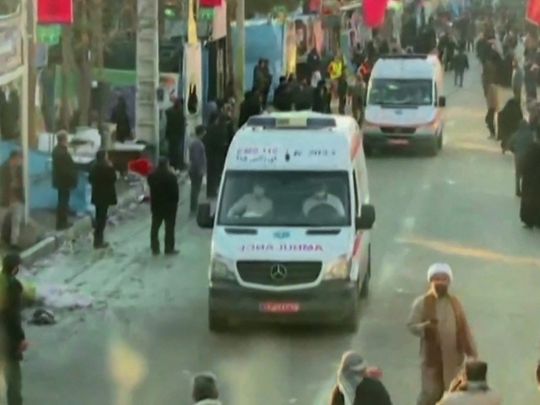
Tehran: Two bombs exploded minutes apart Wednesday at a commemoration for a prominent Iranian general slain in a US drone strike in 2020, officials in Iran said, killing at least 95 people and wounding 211 as the Middle East remains on edge over Israel’s war on Hamas in the Gaza Strip.
Also read
- UAE condemns terrorist attack in Iranian city of Kerman
- US sanctions eight companies over Iran petrochemical sales
- Drones main pillar of Iran’s Quds forces’ overseas operations: opposition
- Trump: Netanyahu ‘let us down’ before the 2020 airstrike that killed top Iranian general
- Jerusalem Post hacked on Iran general’s killing anniversary
No one immediately claimed responsibility for what appeared to be the deadliest militant attack to target Iran since its 1979 Islamic Revolution. The blasts shook the city of Kerman, about 820km southeast of the capital, Tehran, and sent shrapnel hurtling into a screaming crowd fleeing the first explosion.
The gathering marked the fourth anniversary of the killing of General Qassem Soleimani, the head of the Revolutionary Guard’s elite Quds Force, in a US drone strike in Iraq in January 2020. The explosions occurred near his grave site as long lines of people gathered for the event.
Iranian state television and officials described the attacks as bombings, without immediately giving clear details of what happened. Ahmad Vahidi, the interior minister, told state television that the first bomb detonated around 3pm, with the other going off some 20 minutes later. He said the second blast killed and wounded the most people.
* He also helped secure Syrian President Bashar Al Assad’s government after the 2011 Arab Spring protests against him turned into a civil, and later a regional, war that still rages today.
* Declared a “living martyr” by Iran’s supreme leader Ayatollah Ali Khamenei while still alive, Soleimani was widely regarded as a hero for his role in defeating the Daesh (Islamic State) terrorist group in both Iraq and Syria.
* Relatively unknown in Iran until the 2003 US invasion of Iraq, Soleimani’s popularity and mystique grew after American officials called for his killing over his help arming militants with penetrating roadside bombs that killed and maimed US troops.
* A decade and a half later, Soleimani had become Iran’s most recognizable battlefield commander, ignoring calls to enter politics but growing as powerful, if not more, than its civilian leadership.
* Ultimately, a drone strike launched by the Trump administration killed the general, part of escalating incidents that followed America’s 2018 unilateral withdrawal from Tehran’s nuclear deal with world powers.
Soleimani’s death has drawn large processions in the past.
* At his funeral in 2020, a stampede broke out in Kerman and at least 56 people were killed and more than 200 were injured as thousands thronged the procession.
* Otherwise, Kerman largely has been untouched in the recent unrest and attacks that have struck Iran. The city and province of the same name sits in Iran’s central desert plateau.
* Until Wednesday, the deadliest attack to strike Iran since the revolution was the 1981 truck bombing of the Islamic Republican Party’s headquarters in Tehran.
* That attack killed at least 72 people, including the party’s leader, four government ministers, eight deputy ministers and 23 parliament members.
* In 1978 just ahead of the revolution, an intentionally set fire at the Cinema Rex in Abadan killed hundreds of people.
Images and video shared on social media appeared to correspond with officials’ accounts, which said the first blast happened about 700 meters (765 yards) from Soleimani’s grave in the Kerman Martyrs Cemetery near a parking lot. The crowd then rushed west along Shohada, or Martyrs, Street, where the second blast struck about 1 kilometer (0.62 miles) from the grave.
A delayed second explosion is often used by militants to target emergency personnel responding to the scene and inflict more casualties.

Iranian state TV and state-run Irna news agency quoted emergency officials for the casualty figures, which rose rapidly in the hours after the explosions. Authorities declared Thursday would be a national day of mourning.
Iran has multiple foes who could be behind the assault, including exile groups, militant organisations and state actors.
While Israel has carried out attacks in Iran over its nuclear programme, it has conducted targeted assassinations, not mass casualty bombings. Sunni extremist groups including the Islamic State (Daesh) terror group have conducted large-scale attacks in the past that killed civilians in Shiite-majority Iran, though not in relatively peaceful Kerman.
Iran also has seen mass protests in recent years, including those over the death of 22-year-old Mahsa Amini in 2022. The country also has been targeted by exile groups in attacks dating back to the turmoil surrounding its 1979 Islamic Revolution.
Iran itself has been arming militant groups over the decades, including Hamas, the Lebanese Shiite militia Hezbollah and Yemen’s Al Houthi militants.
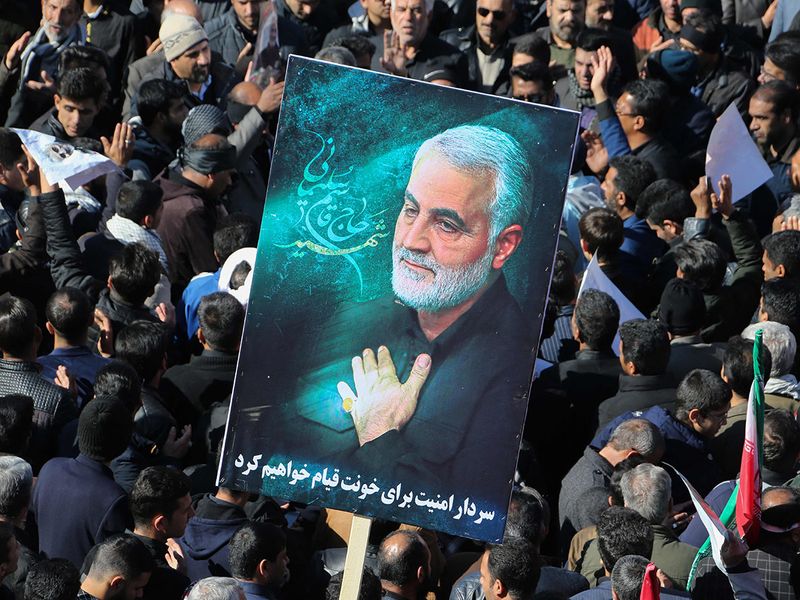
Crowds scramble to flee
The ISNA news agency quoted Kerman mayor Saeed Tabrizi as saying the bombs exploded 10 minutes apart.
Online footage showed crowds scrambling to flee as security personnel cordoned off the area.
Images on state television showed several ambulances and rescue personnel in the area.
Soleimani headed the Quds Force, the foreign operations arm of Iran’s Islamic Revolutionary Guards Corps, overseeing military operations across the Middle East.
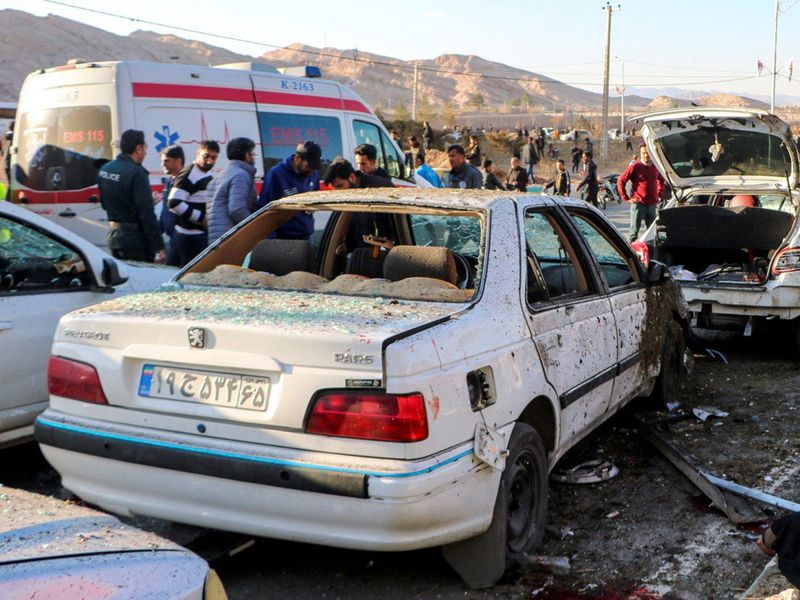
As Israel wages its devastating war in Gaza after Hamas’ October 7 attacks that killed 1,200 people in Israel and saw over 200 others taken hostage, both Hezbollah and the Houthis have launched attacks targeting Israel that they say come on behalf of the Palestinians.
Israel is suspected of launching an attack Tuesday that killed a deputy head of Hamas in Beirut, but that attack saw limited casualties in a densely populated neighborhood of the Lebanese capital.
Mohammad Abdel Salam, an Al Houthi spokesman, sought to link the bombings to Iran’s “support for the resistance forces in Palestine and Lebanon.”
“All attempts by America and Israel to destabilize Iran’s security will fail,” Abdel-Salam wrote online, though he did not specifically blame anyone for the attack.
Turkish President Recep Tayyip Erdogan also offered his condolences over the “heinous terrorist attacks.” Iranian President Ebrahim Raisi had been expected to visit Turkey on Thursday.
Declared a “living martyr” by Iran’s supreme leader Ayatollah Ali Khamenei while still alive, Soleimani was widely regarded as a hero for his role in defeating the Daesh (Islamic State) terrorist group in both Iraq and Syria.
In the eyes of many Iranians, his military and strategic prowess were instrumental in warding off the multi-ethnic disintegration of neighbouring countries such as Afghanistan as well as Syria and Iraq.
Long seen as a deadly adversary by the US and its allies, Soleimani was one of the most important powerbrokers across the region, setting Iran’s political and military agenda in Syria, Iraq and Yemen.
On days after his death in 2020 and leading up to his funeral in Kerman, millions turned out to mourn in a show of national unity.
A survey published in 2018 by IranPoll and the University of Maryland found Soleimani had a popularity rating in Iran of 83 per cent, ahead of then-president Hassan Rouhani and then-foreign minister Mohammad Javad Zarif.


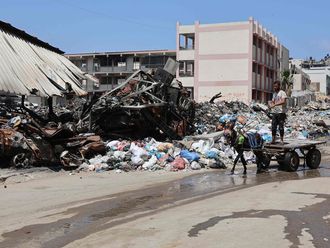


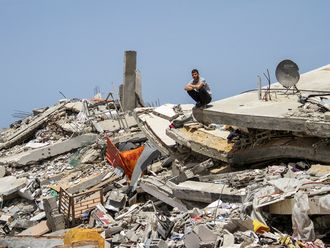




_resources1_16a3106a819_small.jpg)

